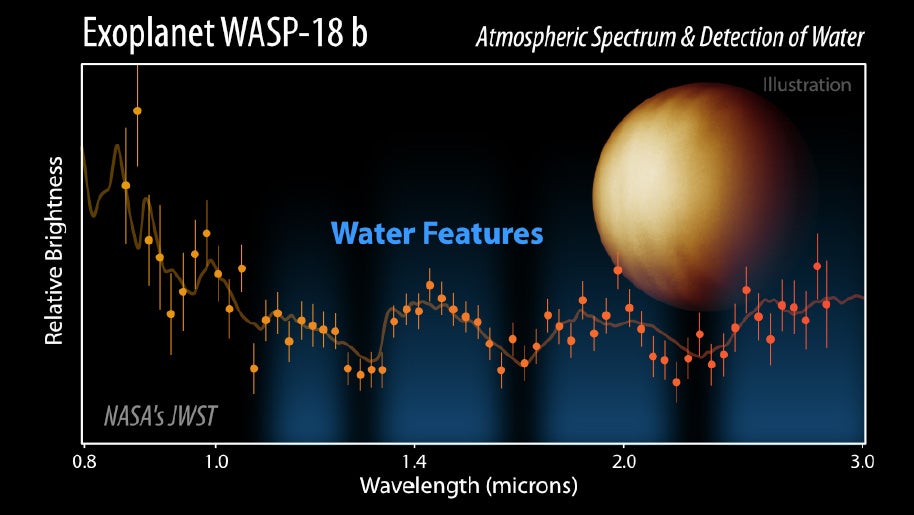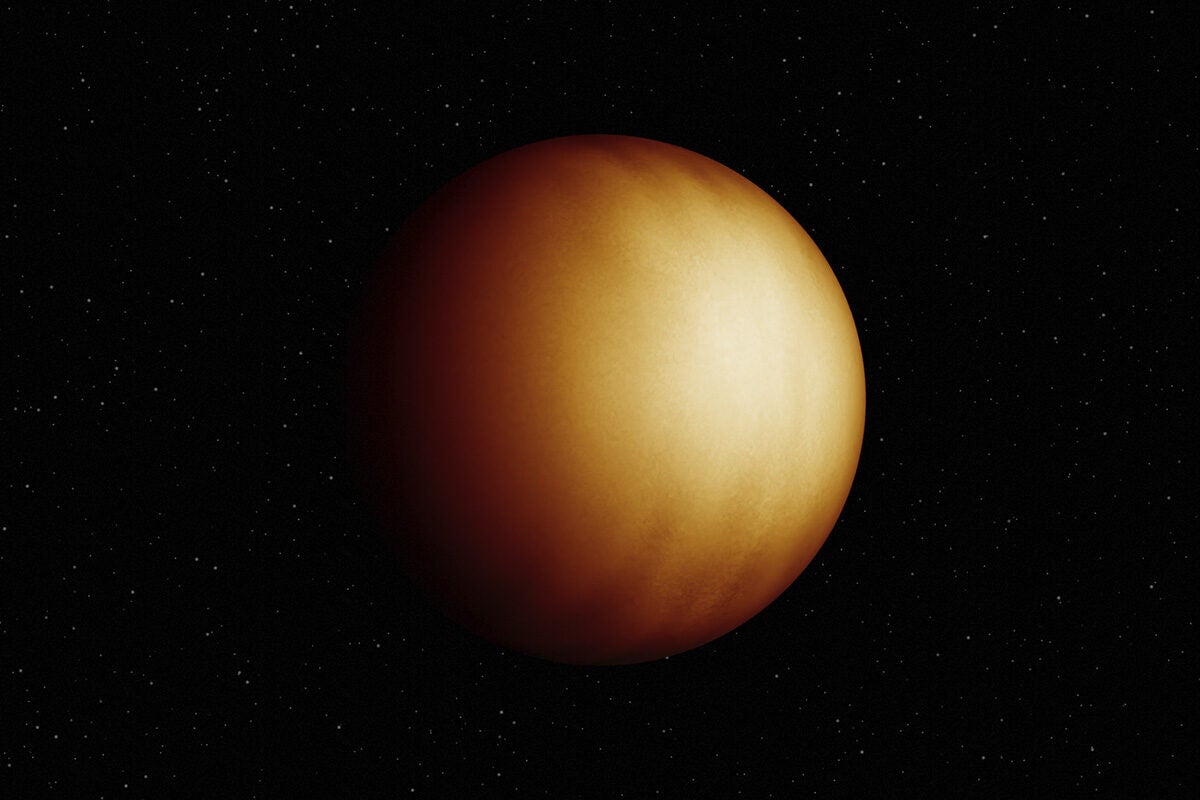A University of Central Florida researcher and multiple alumni are part of a team that has used NASA’s James Webb Space Telescope (JWST) to identify water vapor in the atmosphere of an ultra-hot gas giant exoplanet and make a thermal map of its atmosphere.
Using JWST’s Near-Infrared Imager and Slitless Spectrograph, the team found multiple small, but precisely measured, water features present in the atmospheric spectrum of exoplanet WASP-18b, despite its extreme temperatures of almost 5,000 degrees Fahrenheit.
The results were published today in the journal Nature.
The temperature is so hot that it would tear most water molecules apart, and the researchers say detecting the remaining water that survived speaks to the extraordinary sensitivity of JWST.
Learning more about the atmospheric properties of WASP-18b, including detecting water, advances the understanding of physics in extreme environments and provides valuable data about water’s abundance and distribution in different planetary atmospheres.
The findings also advance observational techniques and instrumentation, which can have broader applications across the field of astronomy.
Alien Weather
In addition to detecting water, the researchers also created a temperature map of the planet. This was an exciting development more than 10 years in the making, says study co-author Joseph Harrington, a Pegasus Professor in UCF’s Department of Physics and Florida Space Institute.

“When my team at UCF made the first measurements of WASP-18b’s dayside by observing its secondary eclipses with NASA’s infrared Spitzer Space Telescope, we had the barest of signals to work with,” Harrington says. “We couldn’t make a map, but our analysis said that the planet was very hot and that it radiated most of the heat it received from its star right back out into the universe, without the winds blowing that heat to the night side.”
Secondary eclipses occur when a planet slips behind its star and reappears on the other side.
Harrington says their finding meant there had to be at least one hot spot on the dayside that was much warmer than the rest of the planet.
“That’s really different from all the planets in our solar system, which have winds blowing the Sun’s heat all around the planet,” he says.
Those findings were published in a 2011 study led by UCF alumna Sarah Nymeyer ’10 that included current study co-authors Harrington and his students at the time, Kevin Stevenson ’12PhD, Jasmina Blecic ’15PhD, and Patricio Cubillos ’15PhD.
The new temperature map was made by study co-author Ryan Challener ’20PhD, another one of Harrington’s students.
“Ryan’s map shows a single, very hot central region facing the star, with a much-cooler surrounding region, confirming what we found in much cruder data,” Harrington says. “It’s like figuring out that there could possibly be such a thing as ice cream, and then, 12 years later and after a lot of work, actually tasting it for the first time.”
This achievement was made possible with the power of JWST, which is Spitzer’s successor, as it has almost 50 times Spitzer’s ability to collect light and much better instruments.
“It has solidly confirmed our finding and moved science to the next level, where we can actually use the data to guide computer models that study this alien weather pattern,” Harrington says.
Strange Planet
WASP-18b is an ultra-hot gas giant 10 times more massive than Jupiter and located 400 light years away. It was discovered in 2009, and scientists have continued studying it ever since, due to its unique characteristics, including its size and its close proximity to its host star, named WASP-18.
Its orbit is so close to WASP-18 that its atmosphere reaches incredibly high temperatures and makes WASP-18b one of the hottest known exoplanets.
The researchers found from their observations that WASP-18b’s composition is very similar to that of its star, meaning it most likely formed from the leftover gas that was present just after the star was born, says the study’s lead author, Louis-Philippe Coulombe, a graduate student at the University of Montreal.
‘‘Those results are very valuable to get a clear picture of how strange planets like WASP-18b, which have no counterpart in our solar system, come to exist,’’ Coulombe says.
How the Research Was Performed
The scientists made their observations for about six hours that included the planet’s secondary eclipse. They measured the combined light from star and planet before and after the eclipse, then subtracted the measurements from just the star as the planet went into eclipse behind it to get a spectrum of the planet alone.
This planetary spectrum showed an atmosphere with temperatures varying by hundreds of degrees between its layers and increasing with elevation.
The temperature, or brightness, map they created shows a huge change in temperature — up to 1,000 degrees Fahrenheit — from the hottest point facing the star to the terminator, where day and night sides of the tidally locked planet meet in permanent twilight. This is the first time that a planet has been mapped with JWST.

The team mapped temperature gradients across the dayside of the planet, and given how much cooler the planet is at the terminator, there is likely something hindering winds from efficiently redistributing heat to the night side, the researchers say.
But they say what is hindering the winds is still a mystery.
‘‘The brightness map of WASP-18b shows a lack of east-west winds that is best matched by models with atmospheric drag,” says Challener, now with the University of Michigan. “One possible explanation is that this planet has a strong magnetic field, which would be an exciting discovery.’’
The researchers say that possibly magnetic effects force the winds to blow from the planet’s equator up over the North Pole and down over the South Pole, instead of east-west, as they would otherwise expect.
About the Team
More than 100 scientists around the globe are working on early science from JWST through the Transiting Exoplanet Community Early Release Science Program led by Natalie Batalha, an astronomer at the University of California, Santa Cruz, who helped coordinate the new research. Much of this groundbreaking work is being done by early-career scientists.
Harrington received his doctoral degree in planetary science from the Massachusetts Institute of Technology in 1995. He joined UCF’s Department of Physics, part of the College of Sciences, in 2006. He began observing and modeling giant planets as an undergraduate at MIT. A pre-impact model of the collision of comet Shoemaker-Levy 9 with Jupiter in 1994 was part of his MIT Ph.D. thesis in planetary sciences. He was part of the team that first measured light from an extrasolar planet, a result published in Nature in April 2005. He continues his exoplanet work at UCF. In 2020, he was named a UCF Pegasus Professor. He served as chair of the UCF Faculty Senate and on the UCF Board of Trustees in 2020-2022.







